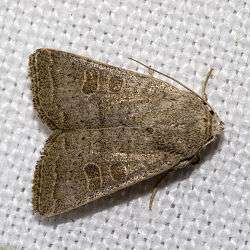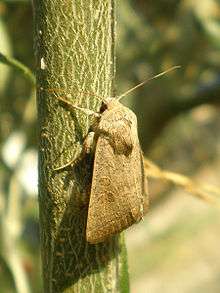Hoplodrina ambigua
Hoplodrina ambigua, the Vine's rustic, is a moth of the family Noctuidae. It is found in the west Palearctic ecozone (central Europe, south Europe North Africa, Russia to Urals, south-west Siberia, Tuva, Altai Mountains, Tadjikistan, Turkestan and in the Near East – Iraq, Iran, Afghanistan, Pakistan).
| Vine's rustic | |
|---|---|
 | |
 | |
| Scientific classification | |
| Kingdom: | Animalia |
| Phylum: | Arthropoda |
| Class: | Insecta |
| Order: | Lepidoptera |
| Superfamily: | Noctuoidea |
| Family: | Noctuidae |
| Genus: | Hoplodrina |
| Species: | H. ambigua |
| Binomial name | |
| Hoplodrina ambigua (Denis & Schiffermüller, 1775) | |
Technical description and variation
The wingspan is 32–34 mm. The length of the forewings is 13–15 mm.Forewing greyish ochreous, sometimes uniformly washed with brownish; the lines and stigmata dark grey, the latter with pale annuli; submarginal line luteous preceded by a dark grey shade; hindwing dirty pale grey in male, darker in female, and darker in both sexes in the brown suffused forms: - the form sericea Speyer, from Holland and Germany, is described as having narrower silky grey forewings; -in [now full species levis Stgr.], from W. Turkestan and Asia Minor, the yellower ochreous tint is predominant and the dark markings are conspicuous but in some pale examples from Segovia, Spain- ab. ochrea ab. nov. [Warren] the dark markings tend to become effaced, the head, thorax, and forewings being pale yellow ochreous - amurensis Stgr. indicates small dark examples from Ussuri, Amurland.[1] Similar to and confused with Hoplodrina octogenaria and Hoplodrina blanda. Certain identification requires dissection of the genitalia.[2]
Biology
The moth flies in two generations from early May to mid-October. .
Larva clay coloured, darker dorsally: the dorsal line itself fine and white with dark edges; the subdorsal also fine and pale; laterally a pale dark edged serrate line containing the spiracles. The larvae are polyphagous feeding on various herbaceous plants including Beta vulgaris, Cynara scolymus, Medicago sativa and Taraxacum officinale.[3]
Notes
- ^ The flight season refers to Belgium and The Netherlands. This may vary in other parts of the range.
References
- Seitz, A. Ed., 1914 Die Großschmetterlinge der Erde, Verlag Alfred Kernen, Stuttgart Band 3: Abt. 1, Die Großschmetterlinge des palaearktischen Faunengebietes, Die palaearktischen eulenartigen Nachtfalter, 1914
- Difficult Species Guide
- "Robinson, G. S., P. R. Ackery, I. J. Kitching, G. W. Beccaloni & L. M. Hernández, 2010. HOSTS – A Database of the World's Lepidopteran Hostplants. Natural History Museum, London".
External links
| Wikimedia Commons has media related to Hoplodrina ambigua. |